Updated: 07-Oct-2020
Henri, Maurice and Dick Farman built airplanes that became famous.
-There were also Farman cars.
-In 1915 they began to build aviation engines of various interesting and generally powerful types that have gone unnoticed because the fame of the Farman aircraft eclipsed them.
-In Billancourt, the company's General Director engineer, Charles Waseige, did real wonders, starting in 1917 with a V-8 that gave 200 CV, a twelve-cylinder V giving 280 CV and an 18 W with a power of 500 CV.
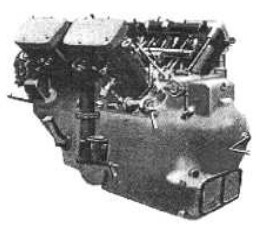
"Farman V-8 giving 200 CV"
-On this engine we see a large crankcase and an incipient rear starting handle.
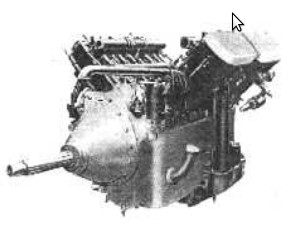
"Farman 200 CV front view"
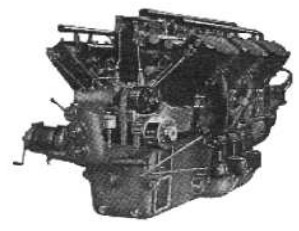
"Farman 18-W"
-This geared 18-W is assigned 600 CV.
-The so bulky starter at the left-rear part was a Ragonet.
-It had a crank for emergency starts from the outside of the plane.
-The Type 18A had 18 cylinders in three groups of 6 cylinders in fan-shape (W). It delivered 600 CV at 1,500 rpm with gearbox.

"Farman 18A"
-In 1920, these same engines had common lines starting from the two cylinder twin blocks. It seems that even the gear was equal, but it is assumed that to absorb the different powers, the sizes were proportional.
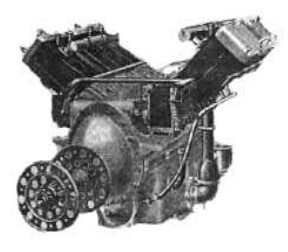
"V-8 giving 200 CV"
-Let's see the case of the V-8. The cylinders were 110 mm in diameter and the stroke of the piston was 160 mm. The powers were between 160 and 200 CV.
-The V-12, had the cylinders with the following dimensions, 120 mm of diameter by 160 mm of stroke. The power between 380 and 400 CV.

"V-12 from 1920"
-And the 18-cylinder W-engine, with 120 mm of diameter by 180 mm of piston stroke and with powers between 550 and 600 CV.
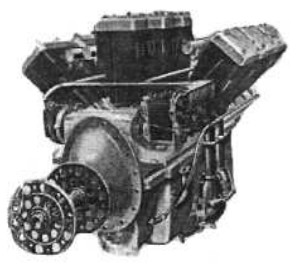
"18-W"
-The 8-VI was an inverted V-8 engine with a triple Rateau-Farman compressor supercharging it to reach 400 CV.
-In 1926, the inverted V-8 comes out giving 350 CV with a compressor. It was the 8-Visc.

"8-VI"
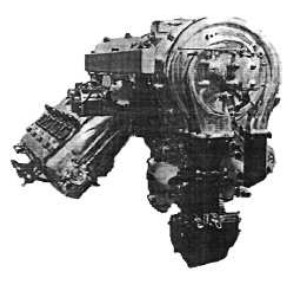
"8-Visc"
-The same engine with gearbox had reference 8-Virsc, and it delivered the same power.
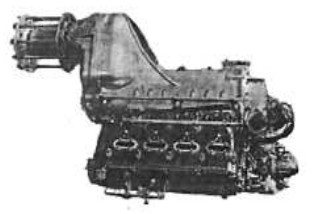
"8-Virsc"
-The 12Brs gave 460 CV at 4,020 rpm. It had 12 cylinders in inverted V and was water cooled.
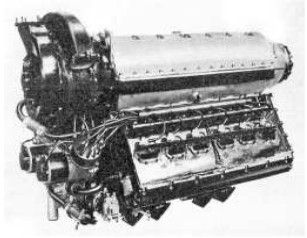
"Farman 12 Brs"
-Between 1922 and 1924, they built the 12 WD with three cylinder rows in fan shape forming a W, that is, a V-engine with another row of vertical cylinders in the middle (formula also used by Lorraine and Napier).
-It reached the 450/500 CV with a formidable Mechanical Rateau compressor.
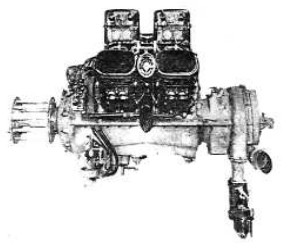
"12-WD and WE, similar"
-The WE delivered 500 CV with a two-speed compressor.
-The power rose to 520 CV at 5,500 meters of altitude.
-This engine was mounted on the Super Goliath F-140 four-engine plane and even more on the twin-engine Farman F-180 "Oiseau Bleu" in 1927.

"12 WE"

"Farman 12WE installation"
-Above we see the installation of the 500 CV WE engine with a Rateau compressor that involved an incipient intercooler like the one shown.
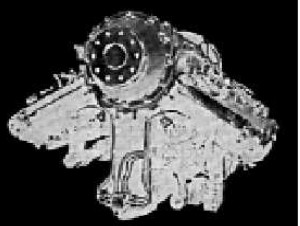
“12 WI” (PiP)
-The WI was similar to the previous one but with the cylinders in W, inverted (WI).
-With the geared 12-WIrs variant that had a two-speed compressor, the power increased from 500 to 550 CV and it was kept at a higher altitude. Year 1933.
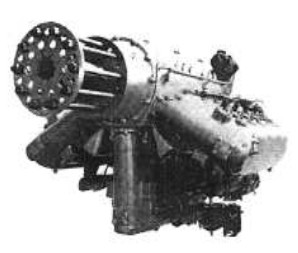
"12-WI"
-In that same year 1933, and for the Deutsch de la Meurthe Cup, the 12 Brs was presented, with 12 cylinders in inverted V giving 420 CV (470 CV at 4,020 rpm).
-This engine was the family head for the 12 Gol, see below.
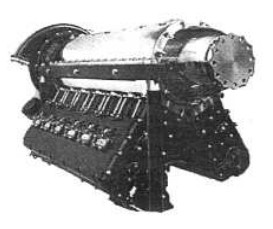
"12 Brs"
-In 1935, the 12 Wkrs were a modernized version of the 12-cylinder WIrs, delivering 600 CV.
-And with 18 cylinders in three rows of 6 cylinders each, the 500-CV Farman 18 WI were manufactured.
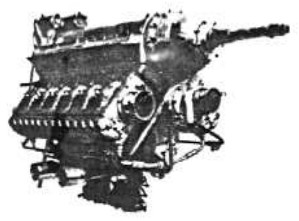
"18 WI"
-Similar to the 12 WIrs, there was the 18WIrs giving 600 CV with gear and supercharger. Year 1928.
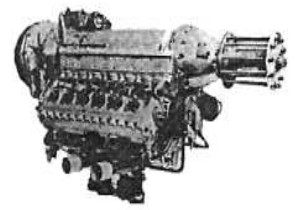
"18 WIrs"
-Of the 18 WD from 1922 it can be said that it was the progenitor of the whole 18-W and 12-W line, because it appeared before all the versions that we have mentioned, even before the eight-cylinder inverted V-engine (Virs).
-The 18 WD already had four valves per cylinder and two spark plugs in each of them.
-Returning to take the previous thread, in 1933 arises the one that was the most powerful of the Farman engines; the 18 T had an authentically original formula with three cylinder rows in T-shape, that is, two rows of horizontally opposed cylinders, and under them, a third one that was vertical inverted.
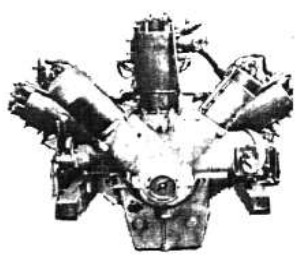
"18-WD"
-With 1400/1800 CV it was destined to the Schneider Cup.

"18-T"
-The idea was to place two engines in tandem, one behind the other and get almost 3000 CV.
-It should be mounted on a Bernard seaplane and the effort was useless as the airplane did not take shape.
-It was expected to exceed 700 km/hr.
-Also for racing, apart from the 12-B mentioned above, there was the 12V series, such as the 12-G-VI 12-cylinder inverted-V at 60°, with gear and compressor and almost 13 liters of displacement for a power of 300 CV at 3,200 rpm, peaking 450 CV at 3,400 meters altitude with the compressor's second speed.
-The power equivalent was 800 CV for an engine weight of only 290 Kgs.

"Farman 12-Gol"
-With the compressor's first speed it restored the power at 1,800 meters of altitude and at 5500 mts. with the second speed.
-The 12-Gol variant, which was intended for the Deutsch de la Meurthe Cup, was basically the same as the one mentioned above.
-The supercharging reached 1,120 mm of the mercury column and this increased the compression ratio to 9:1.
-To obtain altitude records, Farman and Engineer C. Waseige, who had a great experience accumulated in compressors and superchargers, approached the "stratospheric" engine variant.
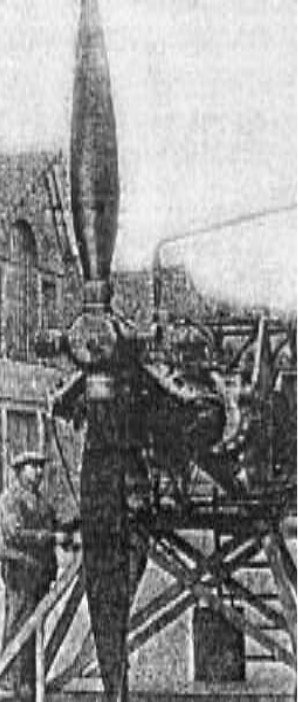
"Stratospheric engine tests"
-This eight-cylinder inverted V-engine had a huge propeller and a triple compressor. This took place in 1931.

"Motor estratosférico"
-Farman also made radial engines.
-The first one was the 9Ea 9-cylinder radial that gave 250 CV in 1930.
-In 1931, the geared 9Ebr.
-In 1932, the 9Eb gave 220 CV nominal, and 287 CV peak power.
-The 7-cylinder 7Ea model was also from 1932 and had a power of 150 CV, and the /Ears model was from the same year and gave 170 CV.
-The 7Ec had a compressor.

"9Eb"
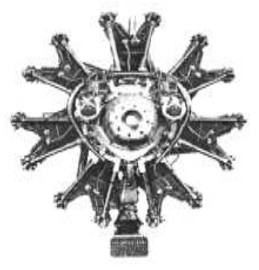
"7Ea"
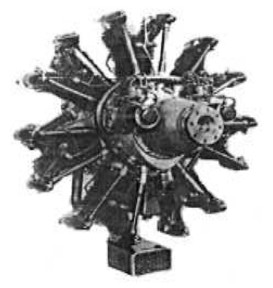
"7Ears"
-Eventually in 1937, Farman was nationalized along with Bleriot, Les Mureaux and ANF, forming SNCM that, when Lorraine joined them, soon after that, it became the controversial SGMA.
From Appendix 6: An engine of this brand, the 12WE, we have found exposed at the Munich Museum.
-And new photographs have been taken to have a better understanding of this engine.
-We can see the cylinder disposition two by two in W, but the twin blocks are rather separated.
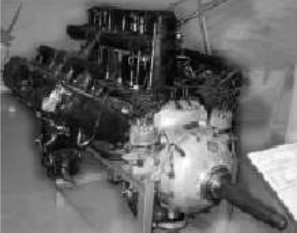
"Farman 12WE"
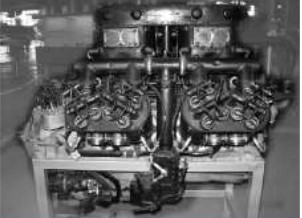
"Detail of the rocker boxes"
-They had four valves per cylinder with a rocker mechanism driving them two by two.
-The feeding system from the carburetors is unique: the right carburetor supplies mixture to the right bank and also to the row of vertical cylinders, it is therefore greater than the left-side carburetor that only supplies one cylinder bank.
-This difference in sizes can be seen in the two photographs below. By the way, the photos have been supplied by AAMA.
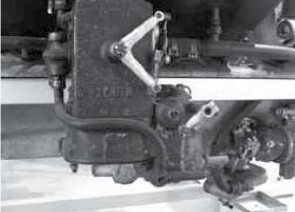
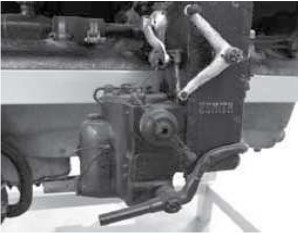
“Diferencia entre carburadores”
-In 1925 two photographs of the Farman 12WD known as "Broad Arrow" were published for having the outer cylinder rows very open, and also the 18WD.
-The first twelve-cylinder gave 500 CV.
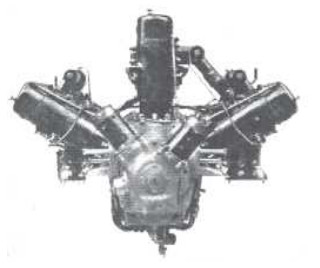
"12-WD, similar to the WE"

"Farman 18-WD"
-We now have a couple of illustrations regarding the Stratospheric Farman that appears in the main text with a large-diameter propeller. Certainly the engine was not the most powerful of the Farman range but it was more supercharged.
-The engine was an inverted V-12 engine that gave 430 CV. It had three superchargers. Possibly two for the engine and one for the cabin pressure.
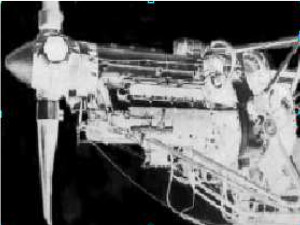
"Stratospheric Farman engine" (PiP)
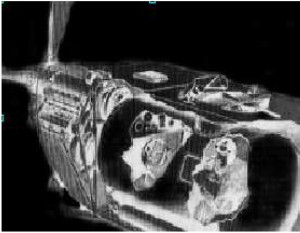
"Pressurized cabin for the stratospheric Farman engine" (PiP)
-To beat the altitude record and/or tests for problems at high altitudes, pilot and observer have a pressure capsule in which they are accommodated when they are not close to the ground.
-For the maneuvers close to the ground, the pilot opens a hatch and his piloting site becomes normal upon the fuselage. In a way, it is like in a submarine.
-From the municipal archives of Boulogne-Billancourt, through Gerard Hartmann, we show a few more detailed photographs of the Farman engines mentioned in the main text.
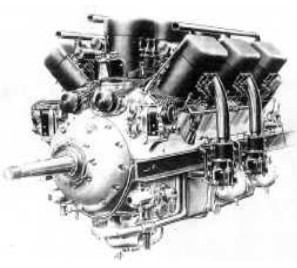
"Farman 18W, model A"

"Farman 18 Wd"
-The 18 WD is from 1924, giving 600 CV. The photo is taken from the 1924 Paris Air Show catalog.
-From the same municipal archive of Boulogne-Billancourt, a curious photo of an articulated bench for testing engines in different positions. It is a Farman Radial 7E, during 1930.
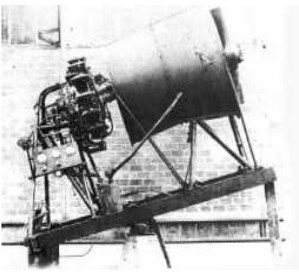
"The 7E radial, with a large cooling fan"

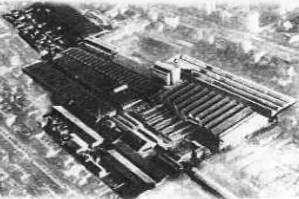
"Farman logo and factory in Boulogne-Billancourt"
-Another facet of the Farman factory was the design and construction of compressors for their engines, to increase power and keep this power at high altitudes.
From Appendix 7: From the Farman 12WE engine we have obtained a photo of the ignition-sequence plate, which, being three rows of four cylinders each, is very interesting. For a more or less profound study.
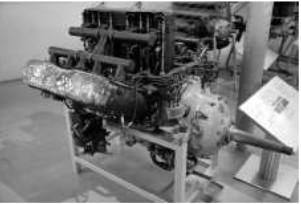
"Farman 12WE engine"
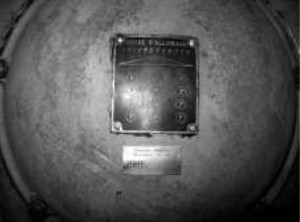
"The ignition-sequence plate"
Engines of FARMAN
Model: 12-B
Arquitecture:
Cooling:
Total Displacement:
Bore / Stroke: x
Power:
Weight:
Model: 12-Brs, 460
Arquitecture: 12-cylinder Inverted V-engine
Cooling: Liquid
Total Displacement:
Bore / Stroke:
Power: 460 @ 4020 rpm
Weight:

"Farman 12 Brs"
Model: 12-G-VI
Arquitecture: Inverted V-engine
Cooling:
Total Displacement: 13 Ltr.
Bore / Stroke:
Power: 300 CV @ 3200 rpm
Weight:
Model: 12-Gol
Arquitecture: 12-cylinder Inverted V-engine
Cooling:
Total Displacement:
Bore / Stroke:
Power:
Weight:

"Farman 12-Gol"
Model: 12-V
Arquitecture: V-Engine
Cooling:
Total Displacement:
Bore / Stroke: 120 x 160 mm
Power: 400 CV
Weight:
Model: 12-WD
Arquitecture: 12-cylinder W-engine
Cooling:
Total Displacement:
Bore / Stroke:
Power: 500 CV
Weight:

"Farman 12-WD -similar to the WE-"
Model: 12-WE
Arquitecture: 12-cylinder W-engine
Cooling: Liquid
Total Displacement: 25.48 Ltr.
Bore / Stroke: 130 x 160 mm
Power: 500 CV
Weight: 470 Kg
With a two-speed compressor

"Farman 12 WE"
Model: 12-WI
Arquitecture: 12-cylinder W-engine
Cooling:
Total Displacement:
Bore / Stroke:
Power: 500 CV
Weight:

"Farman 12 WI fig.2"
Model: 12-WIrs
Arquitecture: 12-cylinder W-engine
Cooling:
Total Displacement:
Bore / Stroke:
Power: 550 CV
Weight:
With gear and compressor
Model: 12-Wkrs
Arquitecture: 12-cylinder W-engine
Cooling:
Total Displacement:
Bore / Stroke:
Power: 600 CV
Weight:
Modernized version of the 12-WIrs
Model: 18-T
Arquitecture: 18-cylinder
Cooling:
Total Displacement:
Bore / Stroke:
Power: 1800 CV
Weight:

"Farman 18-T"
Model: 18-WD
Arquitecture: 18-cylinder W-engine
Cooling:
Total Displacement:
Bore / Stroke:
Power:
Weight:

"Farman 18 Wd"
Model: 18-WI
Arquitecture: 18-cylinder W-engine
Cooling:
Total Displacement:
Bore / Stroke:
Power: 500 CV
Weight:
Inverted W.

"Farman 18-WI"
Model: 18-WIrs
Arquitecture: 18-cylinder W-engine
Cooling:
Total Displacement:
Bore / Stroke:
Power: 600 CV
Weight:
Inverted W with gear and supercharger

"18 WIrs"
Model: 7-Ea
Arquitecture: 7-cylinder Radial
Cooling:
Total Displacement:
Bore / Stroke:
Power: 150 CV
Weight:

"Farman 7Ea"
Model: 7-Ears
Arquitecture: 7-cylinder Radial
Cooling:
Total Displacement:
Bore / Stroke:
Power: 170 CV
Weight:

"Farman 7Ears"
Model: 8-VI, 400
Arquitecture: 8-cylinder Inverted V-engine
Cooling:
Total Displacement:
Bore / Stroke: 110 x 160 mm
Power: 400 CV
Weight:

"Farman inverted V-8 engine"
Model: 8-VIsc, -VIrsc
Arquitecture: Inverted V-engine
Cooling:
Total Displacement:
Bore / Stroke:
Power: 350 CV
Weight:
The Virsc was geared.

"Farman 8-Virsc"
Model: 9-Ea, 250 CV
Arquitecture: 9-cylinder Radial
Cooling:
Total Displacement:
Bore / Stroke:
Power: 250 CV
Weight:
Model: 9-Eb
Arquitecture: 9-cylinder Radial
Cooling:
Total Displacement:
Bore / Stroke:
Power: 287 CV
Weight:

"Farman 9EB"
Model: 9-Ebr
Arquitecture: 9-cylinder Radial
Cooling:
Total Displacement:
Bore / Stroke:
Power: 250 CV
Weight:
Geared.
Model: Stratospheric (inverted V-8)
Arquitecture: 8-cylinder Inverted V-engine
Cooling:
Total Displacement:
Bore / Stroke:
Power:
Weight:
With a triple compressor.

"Farman stratospheric engine"
Model: Type 18A, 600
Arquitecture: 18-cylinder Fan-shape
Cooling:
Total Displacement:
Bore / Stroke:
Power: 600 CV @ 1500 rpm
Weight:
Geared.

"Farman 18A"
Model: V-12, 280
Arquitecture: 12-cylinder V-Engine
Cooling:
Total Displacement:
Bore / Stroke:
Power: 280 CV
Weight:

"V-12 de 1920"
Model: V-8, 200 CV
Arquitecture: V-Engine
Cooling:
Total Displacement:
Bore / Stroke:
Power: 200 CV
Weight:

"V-8 de 200 CV"
Model: W-18, 500
Arquitecture: 18-cylinder W-engine
Cooling:
Total Displacement:
Bore / Stroke:
Power: 500 CV
Weight:
Model: W-18, 600
Arquitecture: 18-cylinder W-engine
Cooling:
Total Displacement:
Bore / Stroke: 120 x 180
Power: 600 CV
Weight:
With gear

"Farman V-12 de 1920"


